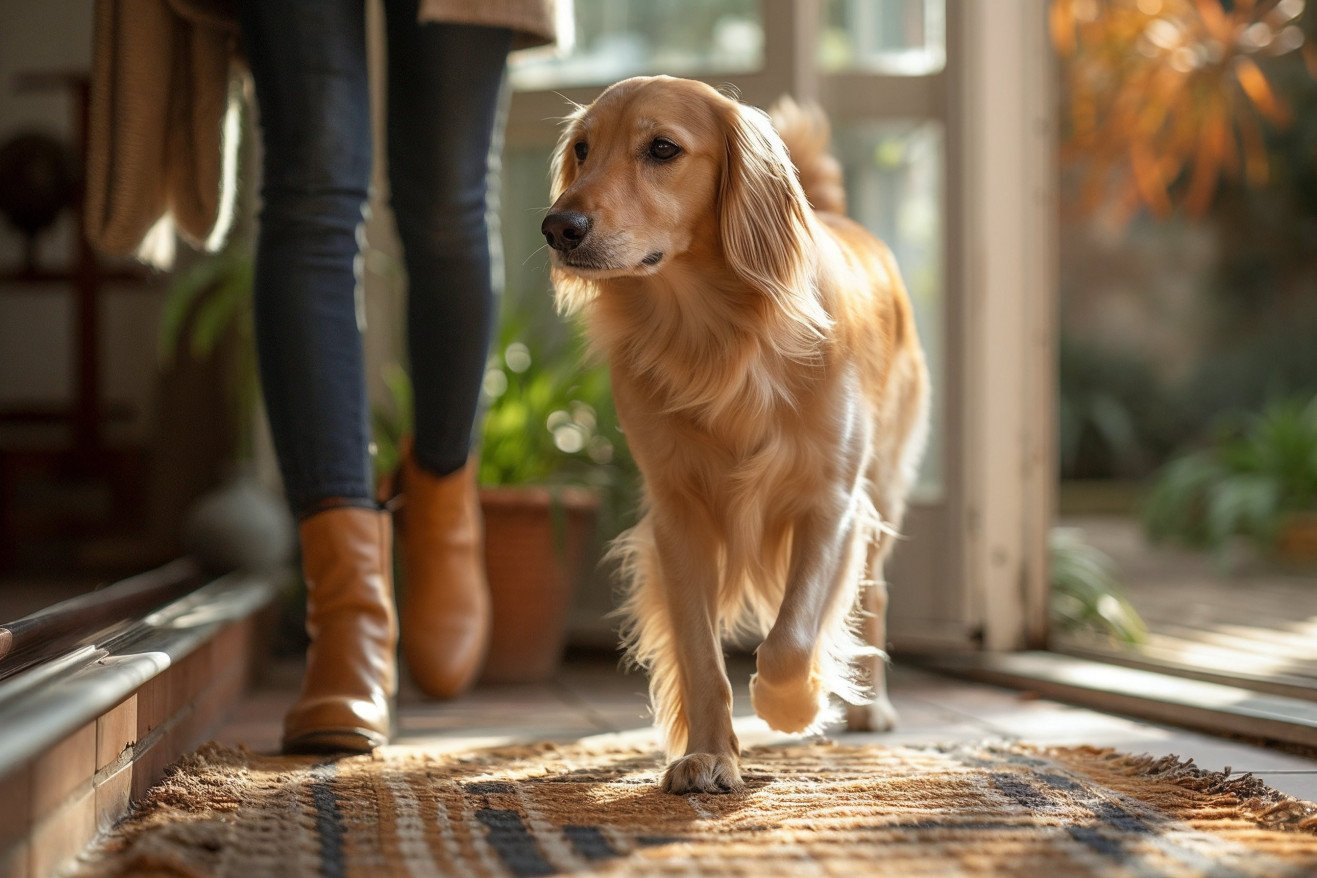Why Does My Dog Follow Me Everywhere? Insights Into Canine Companionship
6 February 2024 • Updated 6 February 2024

If you’ve ever noticed your dog’s constant presence as they follow you from room to room, you’re not alone. Dogs are known to be especially loyal to their owners, and this behavior is often a sign of bonding, pack instinct, or separation anxiety.
Some dog breeds are more prone to this behavior than others. However, there are a number of ways that you can work with your dog to help them feel more secure and less likely to follow you around all the time.
To understand why your dog is following you around like a furry shadow, we’ll look at research from animal behaviorists, insights from dog psychologists, and information from veterinarians. Together, these sources will help us understand how breed-specific traits, the environment, and the complexities of the human-dog relationship all play a role in this behavior.
We’ll also look at how these factors come together to impact your dog’s behavior and provide tips for helping your dog develop a healthy sense of attachment and independence.
Why does my dog follow me everywhere?
The Pack Instinct: Why Your Dog Follows You Everywhere
Dogs’ pack mentality, inherited from their wolf ancestors, drives them to stick close to their pack leader, which is you. This remnant of their wild past is a key reason why dogs follow their owners. According to the American Kennel Club, dogs have a pack instinct that impacts the social structure of a household, leading dogs to consider their human family members as their pack.
This is reinforced by imprinting, a formative period in a puppy’s life. As Petco’s national dog training manager Darris Cooper notes, the experiences a dog has during this time can have a lasting impact on their behavior, including their tendency to follow their human family members as they would their mother.
In addition to these factors, a dog’s breed can also impact their tendency to follow their owners. For example, pack-oriented working breeds like Border Collies and Labrador Retrievers, which were bred to work closely with humans, may be more likely to follow their owners.
In the end, dogs follow their owners because it meets their need for social connection, which is essential to their overall well-being, and shows that their owners are a source of comfort and support.
Coping With Canine Separation Anxiety
Dogs are known to suffer from separation anxiety, which is a clinical syndrome characterized by behaviors like shadowing, vocalizations, and destruction when dogs are left alone. This anxiety is thought to be caused by an unhealthy attachment, which is a dog’s version of an attachment disorder. According to research published in PMC by Rebecca J. Sargisson, separation anxiety is an attachment disorder, similar to the attachment bond between human caregivers and their children.
The way that a dog’s owner behaves can have a major impact on the severity of their dog’s anxiety. According to PetMD, this means that sticking to a schedule and avoiding punishment can help dogs avoid anxiety and the behaviors that come with it.
In addition, the way that an owner feels can be transferred to their dog, so it’s important to make sure that you’re in a good headspace before you leave your dog alone.
That said, it’s important to make sure that you’re setting your dog up for success by creating a supportive environment, providing mental stimulation, and giving them a safe space.
In more extreme cases of separation anxiety, Sargisson says that systematic desensitizationa process in which the dog is slowly exposed to being aloneis often used and can be more successful when paired with a professional.
If your dog is showing signs of extreme attachment, it’s important to talk to your vet or a certified animal behaviorist. By doing so, you can help your dog overcome their attachment issues and build a stronger, healthier relationship with your pet.
Understanding Dog Behavior: Genetics vs. Breeds
Although it is easy to assume that certain dog behaviors are based on their breed, recent studies have shown that breed alone is a less reliable predictor of behavior than previously believed. One study of more than 18,000 dogs, as reported by PetMD, showed that breed only accounts for about 9% of a dog’s behavior, demonstrating the complex relationship between genetics and environment.
This calls into question the breed personality descriptions provided by the American Kennel Club, which are often thought of as a guarantee of certain behaviors.
Historically, certain breeds have been bred for qualities that make them better companions and workers for humans, which could affect their likelihood of being more loyal. For example, the American Kennel Club says that herding dogs have gene variants that are associated with social cognition and learned fear responses, which could make them more likely to form a strong bond with their human counterparts.
That said, individual dogs can have very different personalities, even within a breed.
One study, as reported by Science.org, showed that the most important thing to remember is that each dog is an individual whose personality is shaped by a unique set of life experiences, as well as things like socialization and training.
While it can be helpful to understand breed-specific behaviors when it comes to training and managing behavior, it’s important to remember that each dog is an individual and to take their unique personality into account when it comes to managing their behavior so that you can help them achieve a healthy balance of companionship and independence.
How to Create an Environment That Encourages Independence
Your dog’s environment and daily routine play a big role in how likely they are to follow you. An article on the effects of environmental enrichment on dog behavior explains that a stimulating environment is important for a dog’s mental and physical well-being, and a lack of environmental enrichment can lead to anxiety and other problem behaviors, including separation anxiety and being too clingy.
Housing, including the amount of space and access to the outdoors, is one of the most important factors in promoting independence in dogs. A small, unchanging environment can lead to a dog being more likely to follow their owner because the owner is their primary source of interaction. On the other hand, a stimulating environment can lead to a dog that’s more likely to explore and entertain themselves.
As Leerburg points out, the environment can have a huge impact on a dog’s behavior, and that’s why it’s important to have a routine that’s both consistent and varied and engages your dog in different ways.
You can also help your dog feel more secure when you’re not around by providing structure in their day, such as by taking them for a walk at the same time every day and making sure they get playtime on a regular basis.
You can also help your dog be more independent and less likely to follow you by creating an enriching environment that’s tailored to their individual needs. This can include adding puzzle toys, interactive feeders, and opportunities for sensory exploration. A consistent routine can also help provide a sense of security and predictability, which can help reduce the need for constant companionship.
By creating an environment that meets your dog’s natural needs and allows for predictability, you can help ensure that you have a well-rounded, independent dog.
How to Encourage Independence Through Training
To help your dog overcome their shadowing behavior, you will need to use training and behavior modification. Dogmantics recommends training your dog to be comfortable alone in a room with you by using baby gates to create a visual barrier.
This, along with providing interactive toys, can help make alone time a positive experience. The Inquisitive Canine stresses the importance of confidence-building in dogs and recommends life skills training and rewarding independent behaviors. Things like puzzles and games that allow dogs to make choices can help build confidence.
Positive reinforcement plays a big role in this by rewarding dogs for being calm and independent, which will help them continue to do so. Setting boundaries and being consistent in your responses will also help dogs understand what is expected of them. If you’re dealing with more severe cases, it’s best to consult a professional dog trainer or behaviorist. These professionals can offer personalized solutions and guidance to help your dog develop healthy habits.
After looking at the different ways you can train your dog to be more independent, it’s clear that patience and consistency are the most important factors. With the right training, you can help your dog become a more well-rounded and happy pet that can enjoy alone time just as much as they enjoy time with you.
Why Do Dogs Follow You Everywhere? A Recap
Dogs follow their owners because of a combination of instinctual behaviors, pack mentality, and sometimes separation anxiety. Many of these behaviors are also influenced by breed-specific traits that have been honed over generations of selective breeding. However, a dog’s individual personality is also a big factor in how much they exhibit these behaviors, and it can sometimes override breed tendencies.
The chance of a dog following their owner is also heavily influenced by environmental factors and daily schedules. A stimulating environment and a regular schedule can help dogs feel more secure and independent. Training and behavior modification are also important ways that owners can help their dogs learn to cope with and redirect clingy behaviors, ultimately helping them feel more secure and happy.
In summary, it’s important for dog owners to understand and appreciate their dogs’ natural instincts and individual personalities when dealing with their tendency to follow. The pursuit to comprehend why dogs trail their human companions is evidence of the profound connection between dogs and humans, and it’s a bond that can only be reinforced with understanding and compassion.
For those who want to learn more about dog behavior, the American Kennel Club and books and articles by animal behaviorists offer more information on how to build a healthy relationship with your dog.


